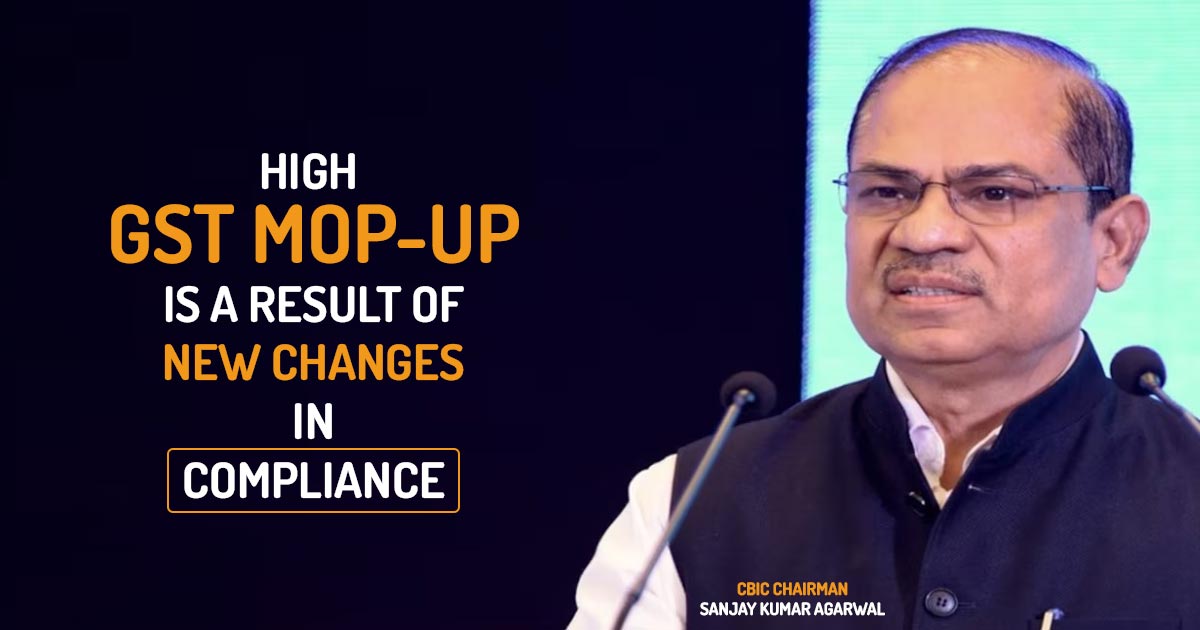
According to SANJAY KUMAR AGARWAL, the Chairman of the Central Board of Indirect Taxes and Customs (CBIC), the buoyancy in goods and services tax (GST) collections will persist throughout the rest of the year.
In a conversation with Shrimi Choudhary at his office in North Block, Agarwal credits the increased collections to improved compliance. Having assumed office recently, he expresses confidence in surpassing the budgetary target for central GST (CGST) collection in the fiscal year 2023-24 (FY24) and expects the gap in excise duty collection to narrow in the latter part of the year.
Here are Edited Excerpts:
The new benchmark for GST collection appears to be Rs 1.6 trillion. Do you anticipate this as the run rate for the rest of the year, or do you foresee further improvement?
In the current fiscal year (FY24), GST collections have consistently exceeded the Rs 1.6 trillion mark each month through August. In April, we achieved a record collection of Rs 1.87 trillion, showcasing robust revenue growth compared to the previous year, with a year-on-year growth rate of 10.3 percent.
The GST buoyancy, when measured against the gross domestic product (GDP), currently stands at 1.43, marking a significant increase in compliance levels. CGST collections between April and August totalled Rs 3.9 trillion, which accounts for 40.8 percent of the total budgetary estimates.
Furthermore, tax collection as a ratio of nominal GDP in the first quarter (Q1) of FY24 is 3.32 percent, compared to 3.22 percent in Q1 of 2022-23.
We expect a further increase in collection figures during the festival season because of raised consumption.
As we’re halfway through the fiscal year, what is your perspective on meeting Budget Estimates (BE)?
Given the current upward trajectory and the approaching festival season, I expect GST revenue collection to remain robust. With a GST buoyancy of 1.43 thus far, we are confident in achieving the BE. Additionally, when we formulate the Revised Estimates (RE) in January, based on the overall collection, we anticipate exceeding the RE.
Excise duty collections saw a decline of 10.5 percent during the first four months of the fiscal year. Do you anticipate alignment with the annual target?
Central excise duty is charged solely on 5 petroleum products: crude oil, aviation turbine fuel, petrol, diesel, natural gas, etc. However, the majority of collections come from fuel items.
The reduction in duty rates on petrol and diesel in May 2022 resulted in an influential drop in revenue from these items during the first four months of the current fiscal year compared to the previous year.
Read Also: GST Impact on Petroleum Products in India
Nevertheless, the gap is narrowing as the impact of the duty reduction in subsequent months becomes less significant. Between April and August, central excise collections grew by 9.93 percent, reaching Rs 1.24 trillion. This is primarily attributable to increased fuel consumption between April and July, which has risen by over 5 percent.
Thus, with increased fuel consumption and stable duty rates, we anticipate the gap that occurred in the initial months of this fiscal year will continue to narrow in the remaining part of the year. What are your thoughts on reducing central taxes on petrol and diesel prices?
Oil marketing corporations (OMCs) set the pricing for petrol and diesel depending on a number of variables, including domestic and international prices, currency rates, and transportation expenses. It is difficult to forecast if there will be a drop because OMCs alter their prices in accordance with global trends, which in turn influence central excise revenues.
Have you seen any effects on customs duties as a result of the slowdown in global trade?
International commerce has decreased, which has had an impact on India as well. In accordance with the general situation throughout the world, imports are down from the prior year. Customs duty receipts from April through August were Rs 90,900 crore, up 5.3% growth on a year-to-year basis. The problem seems controllable thus far.
As you recently assumed the role of CBIC chief, what will be your key focus areas?
Our primary focus is on enhancing trade facilitation and ensuring ease of doing business. We are taking every possible step to simplify procedures and encourage self-compliance by taxpayers in both GST and Customs. We are harnessing data analytics tools for targeted enforcement interventions.
Via data and technology usage our interventions are more precise, enabling us to detect cases of duty evasion in both Customs and GST.
We are committed to guaranteeing timely and accurate filing of GST returns, with the percentage of return filing increasing from 78% to 90% in recent months. We stay concentrated on scrutinizing returns, identifying taxpayers through risk analysis, and initiating scrutiny consequently.
How has the response been to GST audits for the existing fiscal year?
The GST Audit, which we started last year, is currently underway. At first, assessees were a little hesitant to provide data for GST audits. But we’ve seen that taxpayers are becoming more open to these audits. They understand that the tax agency is taking this action to assess its internal control systems and quickly spot any inconsistencies. This enables them to take appropriate action and guarantee prompt payment of any underpaid duties.